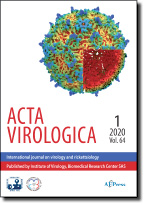Acta Virologica Vol.63, No.2, p.195-202, 2019
|
| Title: Phylogenetic analysis of HA and NA genes of influenza H1N1 viruses from 1918 to 2017 |
| Author: H. X. YAN, H. F. XU, W. J. HE, Y. XIE, G. Y. DONG |
|
Abstract: The 1918 “Spanish” pandemic is the earliest known influenza H1N1 virus. Since then H1N1 viruses circulated between humans and animals continuously. With the increased amount of samples of H1N1 viruses and technology development, researchers have been studying how the viruses evolved. Here, we analyzed HA and NA genes of H1N1 viruses from three aspects: host distribution, geographical distribution and phylogenetic analysis. The data showed hosts were predominantly human, swine and poultry, and other hosts were mainly cat, ferret, wild bear, canine, cheetah and seal. In terms of geographical distribution, the North America and Eurasia were the main H1N1 influenza pandemic areas. Of them, the United States, China, Japan, Canada, the United Kingdom, India and Singapore were the most affected. The phylogenetic analysis of surface genes of influenza H1N1 viruses from 1918 to 2017 worldwide revealed the distribution of all avian influenza viruses (AIVs) showed a clear geographical difference, mainly concentrated in Eurasia and America. American and Eurasian swine viruses might be the ancestors of the 2009 pandemic virus' HA and NA genes. Swine influenza viruses played an important role in the spread of influenza viruses across species. To our knowledge, this is the first large-scale phylogenetic analysis of HA and NA genes of influenza H1N1 viruses worldwide until now. Our findings further emphasize the importance of surveillance of the genetic diversity of influenza H1N1 viruses in different hosts and raised more concerns about the long-time monitoring.
|
|
| Keywords: influenza H1N1 viruses; HA genes; NA genes; phylogenetic analysis; evolution |
|
|
Published online: 28-May-2019
|
| Year: 2019, Volume: 63, Issue: 2 |
Page From: 195, Page To: 202 |
doi:10.4149/av_2019_211
|
|
 download file download file |
|
|
|
|
 download file
download file
